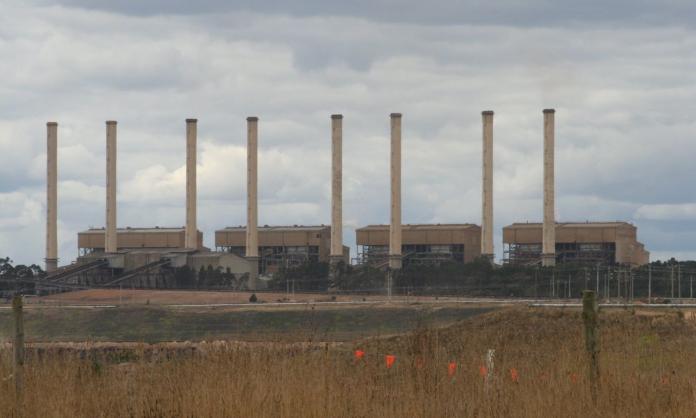Visiting the Latrobe Valley last month, I was startled to learn that the former State Electricity Commission of Victoria was developing a plan to reduce carbon dioxide emissions as long ago as 1988.
I was so surprised that I had to be told twice. I was sitting at their kitchen table with Jenny Jackeulen and Luke van der Meulen—both lifelong residents of the Latrobe Valley, and both former SEC workers. From 1989 until his retirement in 2016, Luke was an elected official of the main union in the power stations, now the Victorian District of the CFMEU Mining Division.
I was visiting to chat about coal, climate and the energy transition. I’d assumed that this discussion was, in practical terms, a handful of years old. A couple of handfuls at most. So, it was a bit of a jolt to be told that, more than three decades ago, the SEC was talking publicly about ways it could start to address the problem of climate change.
Of course, it was not to be.
The privatisation of the SEC was a tragedy for the workers sacked, and for their communities. It was also a tragedy for the prospects of climate action.
The Australian Conservation Foundation wrote in 2000 that the SECV target—cutting carbon dioxide emission to 20 percent below 1988 levels by 2005—was never implemented “because the SECV was split up and sold off by the Kennett government. Had the plan gone ahead, brown coal power stations other than Loy Yang would have been more or less phased out by 2005 ... No such plans have appeared since anywhere in Australia and the way in which the electricity industry was restructured will probably guarantee that such plans do not materialise”.
Perhaps this version is too generous to the former management of the SEC. Leafing through discussion papers titled The SEC and the Greenhouse Effect, released in 1989 and 1992, there is a familiar mix of lofty aspirational words and less-than-sweeping concrete measures. The SEC had gone as far as fitting out a house with photovoltaic panels, but the costs were high. A focus on energy efficiency, rather than new generating technology, was recommended—for the short term, at any rate.
Still, reducing CO2 emissions from electricity by 20 percent by 2005 would have been a handy start to the colossal task confronting us in building a zero-emissions economy. But any plans to reduce carbon emissions didn’t survive the break-up and privatisation of the SEC. And leaving electricity in the hands of massive profit-driven corporations since then is one important part of the story of the 34 years since 1988.
Jenny and Luke reminded me that Labor, as much as Liberal, are responsible for this debacle. After all, it was Labor Premier Joan Kirner who began the process of breaking up and privatising Victoria’s electricity grid.
Loy Yang B was hived off from the SEC and partially privatised. Transmission and distribution were put into their own corporate entity, and every part of the SEC was carved up into business units. The workforce of the SEC peaked at nearly 23,000 in the early 1980s, in the early years of the Cain/Kirner Labor government. It had been cut to around 13,000 by the time Jeff Kennett set to work.
Kennett completed, in brutal fashion, what Labor had started.
But Kennett lost the 1999 election. Labor has been in government in Victoria for nineteen of the 23 years since. And until last month, Labor had made no moves at all to reverse these privatisations (or many other Kennett-era privatisations, for that matter—in fact, the opposite).
All of this was going around in my head when, a couple of weeks after my visit to the Latrobe Valley, Victorian Premier Daniel Andrews announced that a revived SEC would be launched as a public-private partnership if Labor wins this month’s election. The revived SEC would be one player among several in Victoria’s privatised renewable electricity market.
Plenty of unions, climate activists and ordinary people have given Andrews a standing ovation for this move. In my opinion, he doesn’t deserve it.
The timing of the announcement, a month out from the state election, might give rise to scepticism given Labor’s longstanding lack of action in this area.
Further scepticism might come from the modelling underpinning Andrews’ new numbers on the energy transition. This hasn’t been publicly released, but according to a leaked document reported by the Australian Financial Review, the whole plan relies on unproven, (and often overhyped), hydrogen gas technology. Hydrogen has often been used as cover for the continuing use of fossil fuels. We have no way of knowing how things will play out here.
But the biggest problem with Andrews’ plan to revive the SEC is that, as Red Flag editor Ben Hillier convincingly argues, the measures announced by Andrews in October will still leave Victoria’s electricity market as one of the most privatised in the country. Commenting by email on Andrews’ announcement, Luke van der Meulen is unimpressed:
“Re-establishing a government body (the second SEC), that funds the transition away from expensive dirty fossil fuels to renewables may provide false hope to some. I see any future government flogging off this new SEC to private corporations, ensuring they dodge the cost and reap the profits of any necessary energy transition. So, again, people again bear the costs and corporations reap the benefits.”
Small-scale interventions in a dysfunctional market, rather than pushing for full public ownership, mean the tragedy of the past 34 years will continue. Compared to recent history, the revival of the SEC seems like big news. But compared to what is actually needed, Andrews’ announcement is not going to touch the sides.
An energy transition worthy of the name has to involve a massive expansion of the electricity grid so all the energy our society uses—for transport, industry, heating and the rest—can come from renewables.
Andrews’ plan is not that. It’s not establishing a public sector workforce roughly the size of our current construction workforce, which is arguably what’s needed to rebuild and expand our grid and drive rapidly towards a zero carbon economy. It’s establishing one, half-privatised, company in a privatised market.
And Australia, and Victoria, are still addicted to fossil fuels.
Rooftop solar has transformed the economics of the electricity market in recent years. By reducing demand for coal-fired power during the previously lucrative afternoon peak, it has dramatically squeezed the profits of the generators. But if we take a step back and look not just at electricity but at total energy—including transport as well as gas burned in homes and industry—the picture is bleak.
The most recent official figures show that 92 percent of final energy consumption in Australia in 2020-21 came from fossil fuels. Just 8 percent came from renewables, broadly defined. In Victoria it was just 6 percent. And the closer we look at these figures, the worse they get.
Wind and solar are the only realistic paths to a zero emissions economy. We can’t dam every river and probably don’t want to. Nuclear power is a toxic industry feeding nuclear weapons and generating nuclear waste. Despite the rhetoric, biofuels are rarely carbon neutral—and they take up land needed for food and carbon storage. So solar and wind are the only real paths forward.
But the shocking truth is that only 3.6 percent of final energy comes from solar and wind in Australia. Internationally, it is much less than 2 percent. Decades of what Greta Thunberg describes as “blah blah blah” have, unsurprisingly, failed to move the dial.
In the 34 wasted years since the SECV first published a discussion paper on the greenhouse effect, the global temperature increase above pre-industrial times has doubled—from 0.5 degrees to 1 degree. That’s enough to produce record-breaking bushfire and flooding events every year. Or every month.
Australia’s hottest year on record was the catastrophic bushfire year of 2019. According to a 2020 report by the CSIRO and the Bureau of Meteorology, 2019’s record temperature “is expected to be an average year in a world where the global mean temperature is 1.5° C above the pre-industrial baseline period of 1850–1900”. So our hottest year ever becomes an average year at 1.5 degrees of warming. And we’re headed way past 1.5 degrees, as nearly everyone acknowledges.
Yet still we get token efforts, based on unspecified but dubious modelling, announced by Daniel Andrews a month out from an election. The thought of a state-owned authority, responsible for planning, generating and delivering the electricity supply to millions of people, leading by example with a plan to cut carbon dioxide emissions, is a powerful one. It’s also one that is totally at odds with the priorities of capitalism—over the past 34 years and into the future. It’s enraging.
Hope can be a difficult thing to find in bleak days. There’s a powerful attraction to the idea that someone, much more powerful than we feel we are, has finally sorted it out. But false hope is the enemy of effective action, just as much as despair. In a recent widely shared essay on the climate crisis, Rebecca Solnit writes:
“When you take on hope, you take on its opposites and opponents: despair, defeatism, cynicism and pessimism. And, I would argue, optimism. What all these enemies of hope have in common is confidence about what is going to happen, a false certainty that excuses inaction. Whether you feel assured that everything is going to hell or will all turn out fine, you are not impelled to act.”
Solnit quotes a survivor of the genocidal Pol Pot regime in Cambodia: “If I had not hoped, I would not have struggled. And if I had not struggled, I would not have survived ...”
In this sense, hope is compulsory. For a socialist, hope is also not hard to find.
Hope is in the fact that the vast majority of the world’s population—those who work to create the wealth, rather than the few who profit from our labour—have no interest in sending the world further towards disaster.
Hope is in the fact that thousands of years of human history show that we’re capable of making and remaking seemingly unchangeable social conditions. How many times did the slaves, or the medieval peasants, rise up against their masters?
Hope is in the fact that we do all the god-damn work and can stop doing it.
Hope is not remote. Hope is concrete.
Hope is sitting around kitchen tables in the Latrobe Valley—or any other working-class area, for that matter—and finding ingenuity, spirit and a spark of resistance.
Building hope is about finding a way to fan that spark into collective organisation and struggle.
In other words: the hope for a better world is found in the struggle to remake our world.









